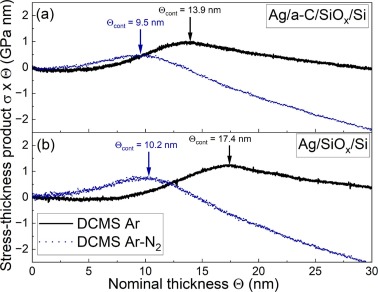Unravelling the effect of nitrogen on the morphological evolution of thin silver films on weakly-interacting substrates (2024)

Applied Surface Science - 2024 - K.Sarakinos
We study the effect of nitrogen on the morphological evolution of thin silver (Ag) films deposited on weakly-interacting amorphous carbon (a-C) and silicon oxide (SiOx) surfaces. Films are synthesized at a deposition rate of 0.1 nm/s by direct current magnetron sputtering (DCMS), high power impulse magnetron sputtering (HiPIMS), and electron-beam evaporation (EBE). We monitor growth in situ and in real time by measuring the evolution of film stress and optical properties, complemented by ex situ analyses of discontinuous-layer morphologies, film crystal structure, and film composition. We find that addition of molecular nitrogen (N2) to the plasmagenic gas (Ar) during DCMS and HiPIMS promotes a two-dimensional (2D) morphology. Concurrently, EBE-deposited films exhibit a significantly more pronounced three-dimensional morphological evolution, independently from the gas atmosphere composition. We argue that the 2D morphology in DCMS- and HiPIMS-grown films is enhanced due to incorporation of atomic nitrogen (N)—result of plasma-induced N2 dissociation—that hinders island reshaping during coalescence. This mechanism is not active during EBE due to the absence of energetic plasma electrons driving N2 dissociation. The overall results of the study show that accurate control of vapor-phase chemistry is of paramount importance when using gaseous species as agents for manipulating growth in weakly-interacting film-substrate systems

